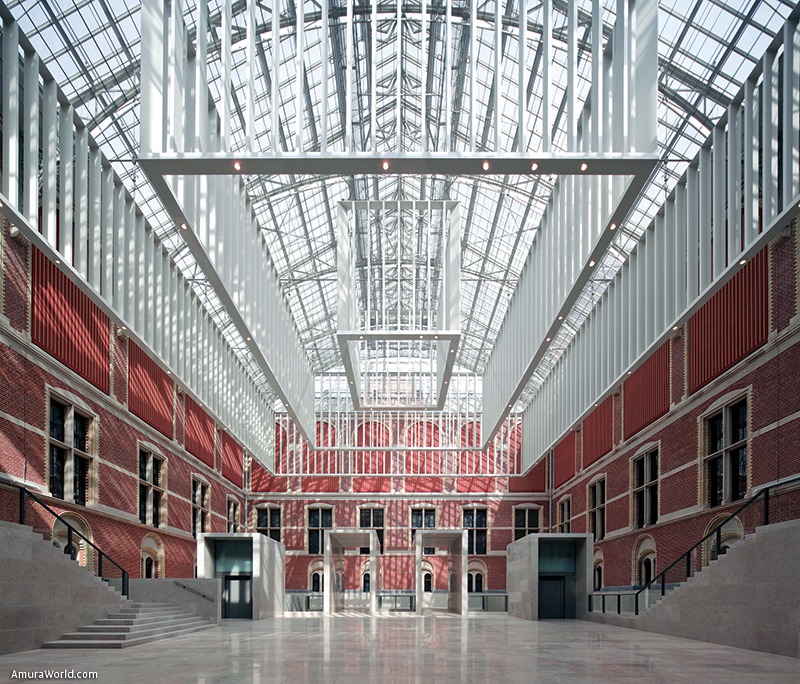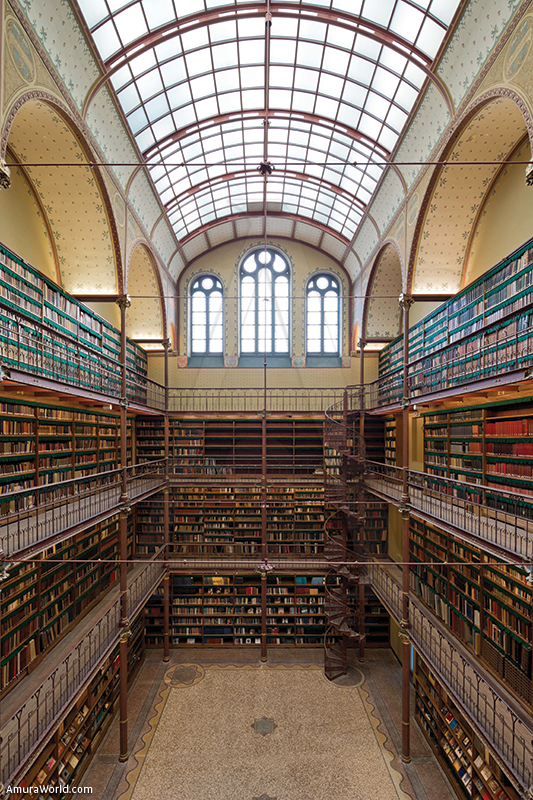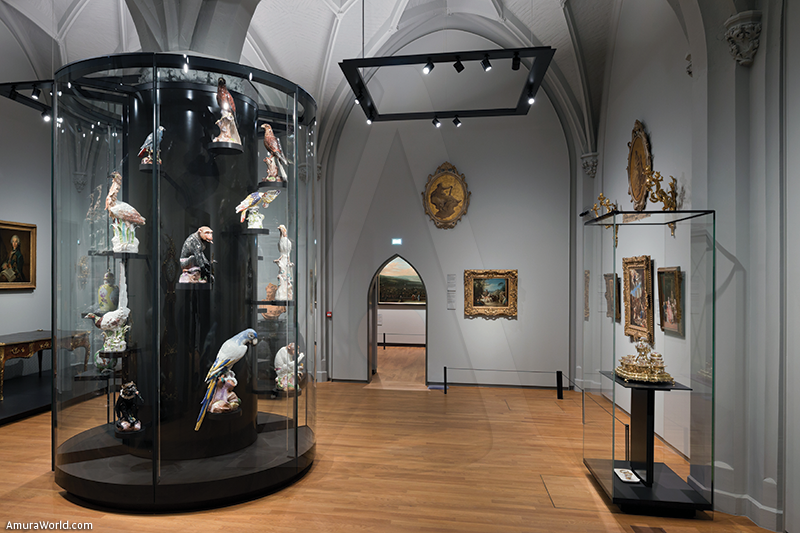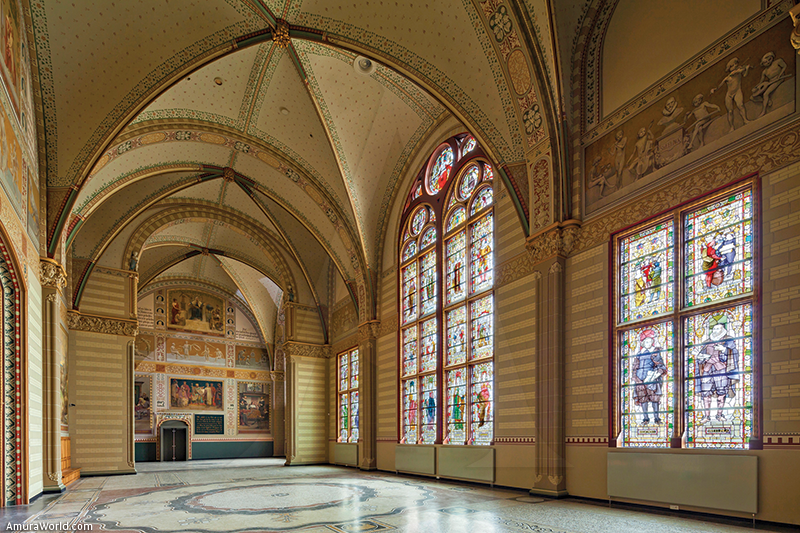Art as you have never seen it before
Exhibition center and work place that possesses over 125 years of history in Amsterdam, a must on the European map of great galleries. The Rijksmuseum is the refuge of “The Night Watch” by Rembrandt, painting that has a special place in the history of art, including masterpieces by Vermeer and Frans Hals. We opened the doors of the new Rijksmuseum, renovated and inaugurated on April 13, 2013. More than a decade of work, an investment whose final expenditure reached 375 million Euros.
It is a great source of knowledge to discover Holland, a beautiful small country with an enviable commercial tradition. “Landscape with an episode of the conquest of America” (1535) is the last painting acquired by the Rijksmuseum. Its author, Jan Mostaert (1474-1552/53), is one of the most renowned painters in the sixteenth century in the Netherlands, portrays the Spanish conquest of the Americas. The book does not glorify this historic event, but, on the contrary, says the brutal foray into the heavenly “New World” by the European invaders. The artist imaginatively represents the contrast of the innocence of the naked Indians, an Edenic and quiet scenery compared to the violence of the Spanish corrupted by greed and will to power. The Dutch always exhibited its cosmopolitan spirit, bold and intrepid marine traders.
The Rijksmuseum was designed by architect Pierre Cuypers, and opened its doors in 1885. It is an imposing building, serious, solid profiles, that stand out in a city of restrained architecture, quite to the extent of human size. The museum houses more than 8,000 works of art that tell the story of Holland throughout 800 years, from the 1200s to the present. The challenge this great national exhibition center had to face in the present was to find a more modern arrangement according to the new needs of a XXI century museum: return the building to coherent architectural integrity, eliminating those added or subsequent extensions and redefine all that greatness Cuypers sets according to specific needs: security, climate and useful spaces to enable shops, restaurants, cafe, auditorium and library...
Architectural solutions
The dilemma of the reform was to introduce desirable developments in space, but continuing with the clear and original style of Cuypers. Spanish architects Cruz and Ortiz have been responsible for the renovation and refurbishment of the Rijksmuseum. The architectural solutions that got a satisfactory answer to all these demands of more dynamic polices which promote life and energy that is so contagious by art. Jean-Michel Wilmotte, recognized by interior decoration of the Louvre Museum, is the author of the interior design. Cabinets, lighting, ornaments and sockets that fit naturally and harmoniously to the old building, all together in close consultation and working jointly with the duo Cruz y Ortiz, Wilmotte’s order was to reconcile the past and the present in a unique and balanced manner. To determine the schema and the set of interior colors, Wilmotte was inspired by Cuypers own palette. The best-preserved monumental ornaments will be returned to strategic locations such as stairwells, the Hall of Honor, the Reception Room and the Gallery “Night Watch”-its main space, named after Rembrandt masterpiece.
A small new building stands as a service entrance, providing access to the museum through an underground passage. Holland is a country of great democratic tradition. The Rijksmuseum is conceived as another public space, another great forum on a beautiful street of cultural Amsterdam. The result of the renovation of the museum was a synthesis of ideas and a continuous negotiation with the participation of the architects, directors, commissioners, policy makers, engineers ... and even Holland’s cyclists. (Along with China, Holland is the country with the highest population density in bicycles, a real national symbol.) Cruz and Ortiz have recognized the influence of this “lobby” in the project through a campaign against public space limitation posed for new works by imposing some modifications on the transit routes for pedestrians and cyclists. Finally, according to the design, the two inner courtyards which were added during the postwar years will be opened, creating an atrium in two parts linked by a corridor that used as a statement will remain in its original form. Water, one of the most influential natural elements of life in the Netherlands, conditioned the foundation. Certain leaks forced to hire divers to perform meticulous welds and underground work. The director of collections, Taco Dibbits, meanwhile, prevented the desire of architects to open more windows so that visitors could navigate. The walls are needed for hanging pictures he said. The museum’s collection will sum approximately 1,000,000 articles, including drawings, prints and photographs. In total, 8,000 pieces exposed to the public.
The remodeling sketches by Cruz y Ortiz, along with photographic images of the development of the work-since 2006 - will be displayed in a permanent exhibit at the museum. After nearly a decade of work, the new Rijksmuseum officially opened its doors last April 13, 2013. After a long period of preparation, it finally began to work in 2004. Policy-makers and cultural managers raised the need for a change in 2000. In 2001 the studio Cruz and Ortiz Architects won the international competition for the reform of the center. They appreciated the proposal of the Spanish tandem, first, functionality gave logistical spaces and workplaces, on the other hand, essential and minimalist vision of architectural solutions posed by the redistribution of space excellently. A final investment of 375 million Euros, financed by the Ministry of Education, Culture and Science as well as a contribution by the own Rijks finalized the project. Among current partners we find Philips, Bank Giro Loterij, ING, KPN.
Total Museum
Rijksmuseum’s renewal is a cultural center that successfully exploited all its spaces and corners. The gardens are one of the most estimable exhibition spaces. Together, they have14,418 square meters. The original design was thought out by Cuypers itself. A remarkable source, the work designed by Jeppe Hein water and a nineteenth century greenhouse as well as other outdoor spaces designed for children with playground, designed by Dutch designer Aldo van Eyc, which will soon enliven the adjacent space. The new Asian Pavilion, another more traditional room stands as a garden wing, which houses many exotic objects of different value, the result of historically maintained trade links with the Pacific Islands and Holland. An outdoor exhibit shows classical statues, sculptures, ornaments fragments and historic buildings. An exhibition of Henry Moore-opened on June 21, 2013 - will be the first of a series of international exhibitions of sculpture that take place every year.
Holland has always been a crossroads and takes center stage on the international scene with burgeoning designers. At one extreme conditioned especially for this purpose, the Rijksmuseum will display special collections. Large samples include porcelain, silver, jewelry, glass and ceramics, as well as weapons and an interesting collection of model ships. Services are located in an area or 3,000 square meters, a lobby who managed to dig this new underground passages that connect the two courtyards of the Rijksmuseum, which was before completely blinded. The Teekenschool (School of Drawing) will house a multidisciplinary school where younger visitors, inspired by the collection of the Rijksmuseum, may unleash creative games and practices.
After the spectacular remodeling, paintings seemed to regain their aura. The medieval and Renaissance art is located in the zero floor, along with the mentioned special collections of porcelain, boats and magic lanterns ... The eighteenth and nineteenth centuries, with some work of Goya, the light brushes of Van Gogh and Dutch Impressionism are located on the first floor. The historical journey continues in the seventeenth century through the second floor with works of young Rembrandt, along with Adriaen Coorte and spaces that combine paintings and objects under different topics: the country’s naval power, the greatness of the national realistic painting, the preponderance of landscape or the representation of everyday life in detail. In addition, as a novelty, it accommodates the contemporary art spaces which were recovered. A Mondrian, among other paintings, are seen on the wings of the two towers. The decision was a challenged by the presence of nearly 200 meters from the Stedelijk, modern art museum in Amsterdam.
The Rijksmuseum is open to the public 365 days a year. Its cultural activity is incessant. From February 12, 2015 until May 17, 2015, a special celebration is planned to mobilize the whole country: a spectacular and ambitious retrospective of Rembrandt will bring together works never before exhibited together. In collaboration with the National Gallery in London, it will be presented to the public as an overview of the work of this great master from 1652 until his death in 1669. Admission is free to young people with up to 18 years of age. Before the reforms, about 1,000,000 people visited the Rijksmuseum annually. Currently, with over 80 galleries and a 1.5 mile walk, the Rijksmuseum will have the capacity to accommodate up to 2,000,000 visitors each year.
Text: Leslie J. López ± Photo: Pedro Pegenaute / Iwan Baan / Jannes Linders. / © Image courtesy of Rijksmuseum









